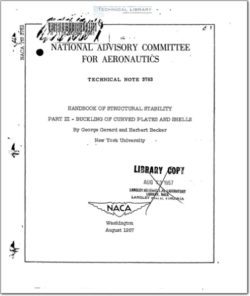NACA-TN-3783

- Version
- 335 Downloads
- 4.46 MB File Size
- 1 File Count
- December 4, 2015 Create Date
- December 4, 2015 Last Updated
National Advisory Committee for Aeronautics, Technical Notes - Handbook of Structural Stability Part III - Buckling of Curved Plates and Shells

Available theories and test data on buckling of curved plates and
shells are reviewed. For torsion and external-pressure loadings, the
test data are correlated in terms of linear buckling theories for both
the elastic and inelastic ranges.
The cases which exhibit a marked disagreement between linear theory
and test data include those of curved plates and cylinders under axial
compression, cylinders under bending, and Spherical plates under external
pressure. These cases have been analyzed by a unified semiempirical
approach for both the elastic and inelastic ranges which is satisfactory
for analysis and design purposes.
The effects of internal pressure on buckling of elements under uni-_
axial loads are discussed and data on various combined loadings are pre—
sented in interaction form.
In Part I ("Buckling of Flat Plates," ref. 1) and Part II ("Buckling
of Composite Elements," ref. 2) of this Handbook the available theories
and experimental data are in relatively good agreement. However, in the
buckling of curved plates and shells, which is treated in the present
report, there is considerable.disagreement between theory and experiment
in many cases. As a consequence, considerable reliance must be placed
on semiempirical methods using theory as a guide. In order to minimize
the use of differing semiempirical approaches which have appeared in the
literature, a unified presentation of experimental and theoretical results
on buckling of curved plates and shells is attempted.
The fundamentals of the buckling behavior of curved elements are
described in the section nPhysical Behavior of Curved Elements" and the
linear and nonlinear theories relating to stability of curved elements
follow in "Stability Theory of Curved Elements." The principles presented
in these introductory sections are referred to throughout the report.
The unification attempted in the various sections utilizes the principles
and theory of the above-named two sections as a guide in establishing semi-
empirical methods where theory is deficient.
| File | Action |
|---|---|
| naca-tn-3783.pdf | Download |

Comment On This Post